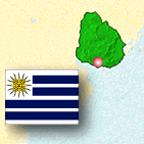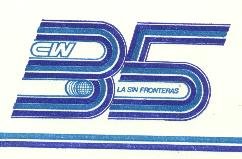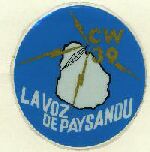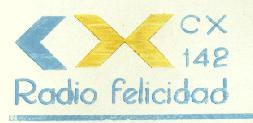(Using notes from my travels, in 1986 I put together this account
of my travels and radio station visits to Uruguay, as part of a
larger body of work on all my South American travels in 1985.
I intended to find some
method of self-publishing this, but the never got beyond the first
draft stage. The text below was scanned from the original document. I
went through it to format for HTML and correct scanning errors, or at
least those that I found. I made
no attempt, however, to do a much needed editing for style, sentence
structure, etc. This is a first draft, and I am sure it reads like
one. The station information, of course, is at least somewhat
outdated.)
We crossed into Uruguay from Agentina at Paysandu, a city a lot like
the US in the 1940s. I really had the feeling I had stepped back in
time. In places such as rural Peru which are far less developed, it
does not feel as much like a different time but as a different
world. Paysandu was the same world, but a different time.
We found lodging in a little place called th Victoria Hotel on 19 de
Julio, the main street. It was run by an older widowed Lithuanian
woman. She had spent her entire life in Uruguay though, and was
thoroughly Uruguayan. The furnishings and decor of the hotel were very
much like that of forty years ago small town USA.
Uruguay is a very pleasant country. There's nothing to see here, or at
least nothing the scale of Tikal or Iguazu. But its just the place for
a relaxing holiday among pastoral countryside, Victorian cities and
towns, and excellant food. During the summer the beaches are said to
be among the best in the world, but crowded with Argentine tourists.
The food, though, is almost reason in itself to make a trip to
Uruguay. I have never eaten better at such a value. In many ways it is
similar to Argentine food, but is priced more reasonably. The national
dish of Uruguay is beef, and huge slices of it are charcoal grilled on
a spit. In a restaurant they simply cut off a slab to serve. It is
weighed and the customer pays by weight, but a very reasonable price.
A pound costs around a dollar. As in Argentina, this is a country
where the salads are safe,to eat, and they make a nice side dish to
either the beef, or the other main Uruguayn dish, pasta.
Pasta in Uruguay is made fresh every day. One shop will have a sign
out that they have ravioli today, another spaghetti, a third
noquis (gnocchi). The Lithuanian woman who ran the Victoria
Hotel had a son living in the US. She visited him once for a month and
was shocked to find it impossible to buy fresh pasta - only that
horrible dry stuff as she put it. So she made him fresh pasta every
day of her visit. She can visit me sometime! I am uncertain why lots
of dry Argentine pasta was brought into Uruguay by so many women on
our bus from Argentina, but I speculate that it is cheaper for the
poorer people. No restaurant in Uruguay would serve dry pasta, nor
would anyone serve it to a guest.
Spaghetti is either served with sauce, or plain with dry chopped
spinach on top. Ravioli was either stuffed with meat and served with a
sauce, or stuffed with spinach and served plain. Noquis were
served with or without sauce. While pasta without sauce may not sound
appetizing to some, that is only because they have never eaten it in
Uruguay. I soon preferred it without the sauce, just a few dried herbs
on top, so I oould better enjoy the fresh pasta. Pasta is a main dish
in Uruguay because that country received many Italian immigrants in
the late 1800s and early 1900s. Many Americans who have been to Italy
have said they found Italian pasta much too greasy, In Urvguay the
pasta is not greasy at all, only superb.
In Uruguay meals are usually accompannied by a local red wine. Besides
the beef, there are a variety of other meat dishes including lots of
sausages. I can t get by without a mention of morcilla dulce -
a type of blood sausage made with ground orange peels and walnuts.
I've never eaten anything like it and it is delicous.
To finish a discussion on Uruguayn food, I must mention masas
surtidas. These are little bite size pastries sold in bakeries.
There are many different types, some moist, some dry, some flaky. One
simply tells the clerk "Give me one of those, one of those, and
two of those ..." The clerk puts the mixture on a scale and they
are sold by weight. They are most of the reason I gained weight in
Uruguay.
Paysandu has four medium wave radio stations, and at the time of my
visit an experimental FM station which I was told about but never
heard on the air. The oldest station in Paysandu is CW33, La Voz de
Paysandu, founded in 1924.
CW39 operates from its original location, about ten blocks from the
central plaza along 19 de Julio. It is a spacious house, now given
over to the radio station. The house originally belonged to station's
CW35 is also on 19 de Julio street, in the second story of one of the
older buildings. They had a great old fashioned neon sign which was
never lit up. They, too, had received European reception reports for
their five kilowatt transmitter on 1240 khz. Also on 19 de Julio,
about halfway between the two, was Radio Felicidad, which was founded
The fourth Paysandu station is Radio Charrua on 1540 khz. This station
is very recent and completely automated. It is located very close to
the main plaza, on Leonardo Gomez street, in one of the few modern
buildings. I walked into the offices several times, but there was
never anyone either in the offices or in the studio as far as I could
see through the window . Probably the staff took advantage of the
automation and went out to get masas surtidas.
From Paysandu to Montevideo we traveled by bus. Urwguayan buses, still
a bargain by American standards, are the most expensive per kilometer
in South America. Quality wise they are only surpassed by Chilean and,
I'm told, Brazilian buses.
Montevideo is a bit like a huge Paysandu with taller buildings and
more traffic. While not as cosmopolitan as Buenos Aires, it is a city.
Buenos AIres is much more interesting to visit, but I think I would
rather live in slower paced Montevideo. We spent several days in
Montevideo, including an overnight trip to a small town called Minas
to the east. Some time was spent in touristic pursuits, such as a
visit to the Gaucho Museum, one of the best of the trip. We also
enjoyed seeeing a Dudley Moore picture and spent lots of time browsing
in the jewelry markets - Uruguay produces a lot of minor gemstones.
Radio station visits were on the agenda for Montevideo. Radiodifusoras
del Uruguay, which runs Radio El Espectador (11835) and Radio Libertad
Sport (6045) was first on the list. I really wanted to meet manager
Jorge Cubilo.
Since the WRTH gives the street address, there was no
problem finding the station - I had already walked within a block of
it several times. They have their own new three story building. The
station occupies the top two stories. The first floor is empty. At the
top of the stairs was a receptionist and off to the left was a huge
room divided into cubicles filled with hardworking people. Very
professional and business like. How dare I ask to see the manager of
such an operation I thought. Still, I did, and being a listener from
overseas was all it took. Jorge Cubilo was out to give me a tour
himself in ten minutes.
The reason I wanted to meet Jorge Cubilo is that I knew he had been
associated with Radiodifusoras del Uruguay for many years. He looks
just like a respected grandfatherly businessman. He still runs this
radio station. The younger members may do the work, but he is
certainly the boss. Everyone respected him. He took me around to the
studios, record library, news room, and the advertising office. News
is one of the mainstays of Radio El Espcctador, and large part ofthe
staff work in the news department. They also receive wire services
from overseas. Sports is also important and a large part of the
programming on Radio Libertad Sport is, of course, sports.
Senor Cubilo took me to one room where they had several old Hammurland
and Hallicrafters sets used to monitor other stations. These, he told
me, are the kind of radios he likes. These date from the days when
radio vas king. Radios made in the way radios should be made.
Grandfatherly Jorge Cubilo standing by those old radios - I will
always think of him when I think of broadcasting in Uruguay.
(Addendum: Jorge Cubilo died at the age of 90 years on April 23, 2000.)
Visiting the government operated SODRE was a bit more trouble. When I
arrived at Mercedes 803, the suppossed address of the station, I found
that the entire block had been demolished. AlI that remained were
piles of brick and other rubble. I went into a nearby office and asked
if SODRE had been in that building. The secretary confirmed that SODRE
had been there, but had moved just recently. The old address was still
in the phone book, and she didn't know where they had moved to. So she
started looking up different government offices in the phone book and
calling them up until someone knew where SODRE had gone. SODRE had
apparently changed phone numbers too, as theirs was disconnected.
As it turned out, the station was only two blocks from our hotel and I
had walked by it several times. However since San Jose 1115 was only a
temporary location, there wasn't a sign up. Walking back through the
hallways it was obvious that they had moved quite quickly into the
partially finished building. The offices were finished, but the halls
and stairways were not. The international service was headquarted for
the moment in the archives room - that just happened to be where
Fernando Manfredi had his desk, and he was the person in charge of it.
SODRE is the national government operated radio station of Uruguay,
the evuivalent of the Radio Nacionals found in most other countries.
As such it operates mainly on MW and FM for a national audience, and
to some extent on shortwave for Uruguayanas abroad. The international
service is a very low priority. SODRE was going through several
changes, mainly due to the return to democracy in Uruguay and freedom
in the media. The old building had been demolished so that a new one
with modern studios and facilities could be built. A not very apparent
change was the change in the station name. Although the initials have
stayed the same, the name hasn't. The old name had been Servicio
Oficial De Radiodifusion Electrica. The new is Servicio Oficial De
Radiotelevison y Espectaculos. More modern sounding, I guess.
Fernando said the international service was temporarily suspended
because the shortwave transmitters were not being used. The
international service is not an organized department or division of
SODRE. Rather, several people with other positions work at it part-
time. Fernando coordinates things and also tries to see that the
overseas mail gets answered. They have an attractive white, blue, and
gold QSL card with an Uruguayan flag superimposed on a map of South
America. The don't receive much mail, but that is to be expected for
such equipment, he said. The transmitters are low power and several
decades old. However, SODRE had recently purchased some six-year-old
used transmitters, still low power, but much newer and in better
condition. Once the engineers finished checking them out, he said,
they would resume broadcasting on shortwave.
We found the Uruguayan people always friendly, and we often had
conversations with them in the shops, parks, and museums. In Uruguay,
by law, all museums are free. It is a practice which encourages people
to go to museums. Each time we visited a museum there was a staff
member there to give us a complete tour and answer all our questions.
No tip was expected because this was their job. Considering Uruguay's
museums with the tour we had in San Pedro de Atacama, Chile and I'd
say the free guides were better than any I've ever paid for.
After Montevideo we went westward along the coast to Colonia, a town
originally founded by the Portuguese but later captured by the
Spanish. The old area of town, which dates to the 1600s, is preserved
as a national monument and includes two seperate museums of the
Portuguese and Spanish colonial periods. The town also has a municipal
museum with one of the best stuffed bird collections I've ever seen.
It was originally a private collection. I stopped in at Radio Colonia,
After Colonia we returned to Paysandu. We had been traveling
constantly over the previous weeks and decided it was time to take
three days to just relax in a peaceful place. The Victoria Hotel in
Paysandu was the place. We learned that on our last night in town, Los
Olimarenos were to give a concert in Paysandu's huge basketball arena,
which seats several thousand people. We bought tickets for about a
dollar each. Everyone was excited. Los Olimarenos had been in
political exile for several years and were only now able to return to
a democratic Uruguay. The concert was part of a welcome back tour
across the country. The songs they played were all good, with lyrics
largely nationalistic and anti-military. That's what fit the mood of
Uruguayans at the time. We left at intermission though because it was
so crowded and people were smoking. We just couldn't stand the thick
clouds of smoke any longer. Unfortunately the nonsmoking movement has
yet to take hold in Latin America.
The followinng day we took the bus to Salto, north of Paysandu and
also along the Uruguay River. A pleasant town, though not so much as
Paysandu, it was worth an afternoon's walk. Concordia, Argentina is
directly across the river from Salto, however the nearest bridge is
acrosss the Salto Grande dam, about twelve miles to the north.
Therefore most local people take the regualrly scheduled launch
service across the river. That was the first time we crossed an
international border by riverboat.
This article is copyright 1986 by Don Moore.
This website is maintained by Don Moore,
Uruguay Menu
Main Menu
What's New
Best of this Site
Radio History
Clandestine Radio
Don Moore's Uruguayan Journal

 Paysandu is a small city of about 100,000 inhabitants, but with the
bustle and business section of a city a quarter that size in the US.
Life was slow, but reasonably prosperous. No chain stores or chain
restaurants - just owner operated places like it once was so long ago.
That can still be found in small town Iowa, but even there the old
ways are being replaced by creeping suburbia. But in Paysandu it still
feels like the proverbial good old days. Even the cars add to that
feeling. I've never seen so many antique (1930s and 1940s) cars on the
road as in Uruguay. I took some rough counts and figured out that ten
to fifteen percent of the cars on the road in Uruguay are very well
cared for antiques.
Paysandu is a small city of about 100,000 inhabitants, but with the
bustle and business section of a city a quarter that size in the US.
Life was slow, but reasonably prosperous. No chain stores or chain
restaurants - just owner operated places like it once was so long ago.
That can still be found in small town Iowa, but even there the old
ways are being replaced by creeping suburbia. But in Paysandu it still
feels like the proverbial good old days. Even the cars add to that
feeling. I've never seen so many antique (1930s and 1940s) cars on the
road as in Uruguay. I took some rough counts and figured out that ten
to fifteen percent of the cars on the road in Uruguay are very well
cared for antiques.  It was soon followed by CW35, Radio
Paysandu. Exactly how developed Uruguay is, and was, as a nation can
be seen by the fact that Paysandu, the second city and a minor one at
that, had had two radio stations for several years before the first
radio station in Central America made it on the air. Uruguay was just
barely behind thc US and ahead of many European countries.
It was soon followed by CW35, Radio
Paysandu. Exactly how developed Uruguay is, and was, as a nation can
be seen by the fact that Paysandu, the second city and a minor one at
that, had had two radio stations for several years before the first
radio station in Central America made it on the air. Uruguay was just
barely behind thc US and ahead of many European countries.  now deceased founder and director, Miguel Penna. The current manager,
Eduardo Estefaell gave me a short tour, typed out a verification
letter for my report made up the street in the Victoria Hotel, and
showed me his collection of reception reports from Scandinavia. Yes,
with 1.5 Kw on 1320 khz, CW39 has made it through to Scandinavia on
several occasions.
now deceased founder and director, Miguel Penna. The current manager,
Eduardo Estefaell gave me a short tour, typed out a verification
letter for my report made up the street in the Victoria Hotel, and
showed me his collection of reception reports from Scandinavia. Yes,
with 1.5 Kw on 1320 khz, CW39 has made it through to Scandinavia on
several occasions.  in the 1940s. It has a two-story high waiting room with a decaying
stained glass skylight at the top. Before it was a radio station, I
suspect the building was a hotel - it looked like it should be a
hotel. Radio Felicidad, too, has received European reports, but its
1420 khz must surely have more power than the one hundred watts listed
in the WRTH.
in the 1940s. It has a two-story high waiting room with a decaying
stained glass skylight at the top. Before it was a radio station, I
suspect the building was a hotel - it looked like it should be a
hotel. Radio Felicidad, too, has received European reports, but its
1420 khz must surely have more power than the one hundred watts listed
in the WRTH.  Also time was spent checking out record stores. Current LPs were
rather high for Latin America at five dollars. Above that customers
paid another dollar if they wanted th record sleeve. If one were on a
budget its possible to buy a record without the sleeve, and presumably
the sleeve without the record. We bought an album, with sleeve, by
Uruguay's best known folk group, Los Olimarenos. Montevideo is also an
excellant place to look for bargains in the closeout bins. We picked
up an older John Denver album for only a dollar and an album of
Ukrainian Christmas music for only 30 cents. We figured we couldn't
go wrong for 30 cents.
Also time was spent checking out record stores. Current LPs were
rather high for Latin America at five dollars. Above that customers
paid another dollar if they wanted th record sleeve. If one were on a
budget its possible to buy a record without the sleeve, and presumably
the sleeve without the record. We bought an album, with sleeve, by
Uruguay's best known folk group, Los Olimarenos. Montevideo is also an
excellant place to look for bargains in the closeout bins. We picked
up an older John Denver album for only a dollar and an album of
Ukrainian Christmas music for only 30 cents. We figured we couldn't
go wrong for 30 cents.  CW1 on 550 kHz, to verify a report I had made earlier in Paysandu.
They too had received reports from Europe, despite using only one Kw.
Obviously Uruguayan MW stations make it quite well to Europe.
CW1 on 550 kHz, to verify a report I had made earlier in Paysandu.
They too had received reports from Europe, despite using only one Kw.
Obviously Uruguayan MW stations make it quite well to Europe. 
Association of North American Radio Clubs
DXer of the Year for 1995.